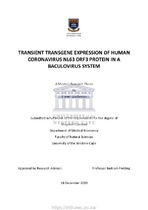Transient transgene expression of human coronavirus nl63 orf3 protein
Abstract
Insect-derived baculoviruses have been used extensively as a safe and versatile research model for transgenic protein expression. Preclinical studies have revealed the promising potential of Baculoviruses as a delivery vector for a variety of therapeutic applications, including vaccination, tissue engineering and cancer treatments. Coronaviruses are enveloped viruses containing linear, non-segmented ribonucleic acid. Human coronavirus NL63 was first discovered in the Netherlands in January 2004, where a 7-month-old girl presented with an acute respiratory tract infection that was later established to predominantly infect infants, the elderly and immunocompromised individuals. In addition to the known non-structural and structural proteins of coronaviruses, an accessory protein known as open reading frame 3 which is conserved in the Coronaviridae family has not been extensively researched. Open reading frame 3 encodes a putative membrane-bound protein. This study cloned the open reading frame 3 viral gene of 741 base pairs into the baculovirus expression construct via competent bacterial cell lines. Open reading frame 3-Baculovirus particles were generated in Spodoptera frugiperda insect cells. Recombinant cells containing the viral protein gene were used to infect healthy Spodoptera frugiperda 9 cells at varying ratios of multiplicity of infection over a fixed time-course. The open reading frame 3 viral protein was not detected by quantification methods at a molecular weight of 26 kilo Dalton, due to polyclonal antibody degradation.

